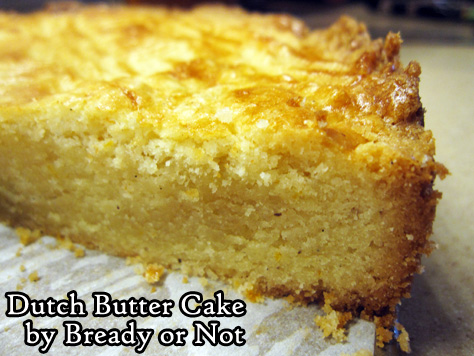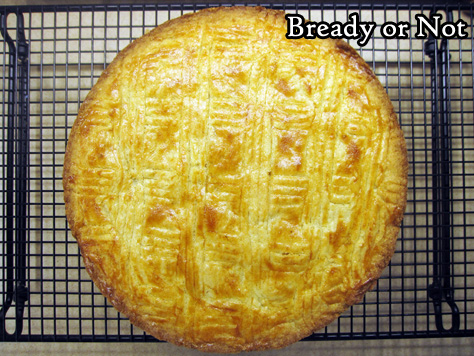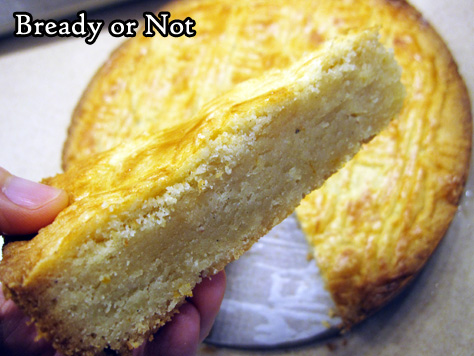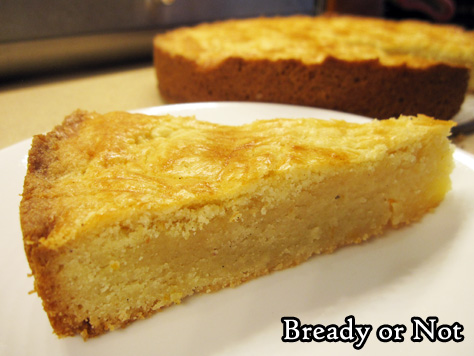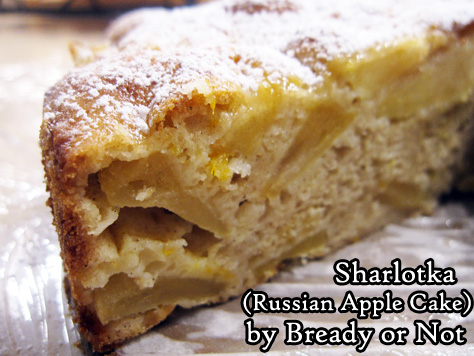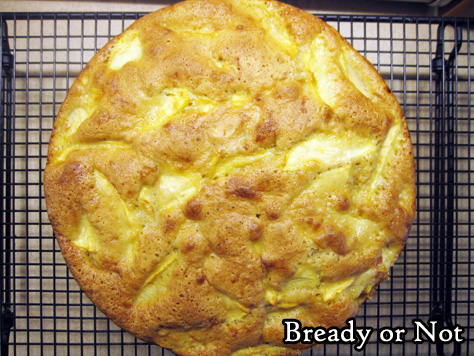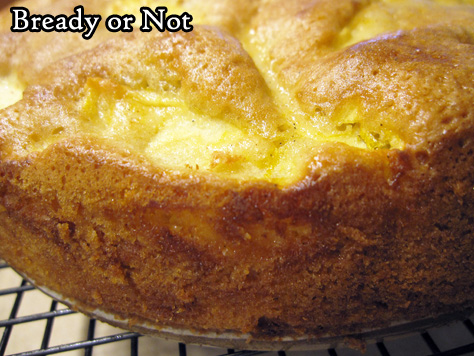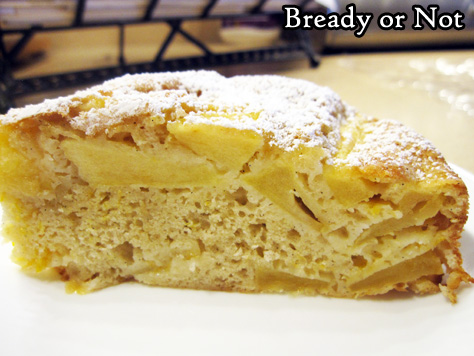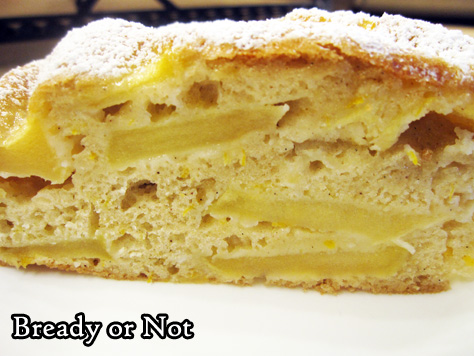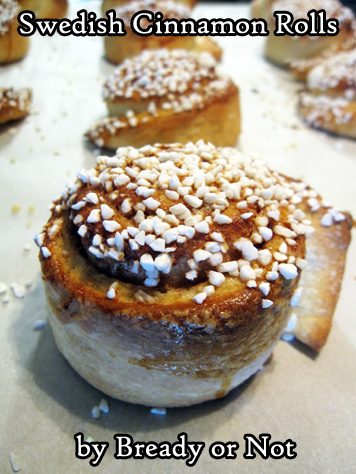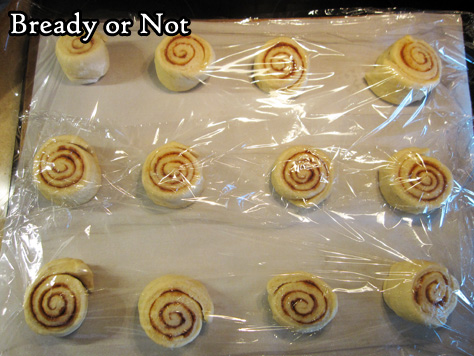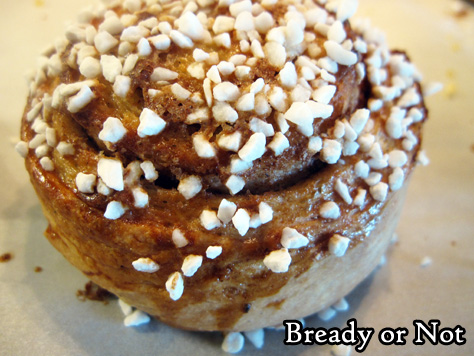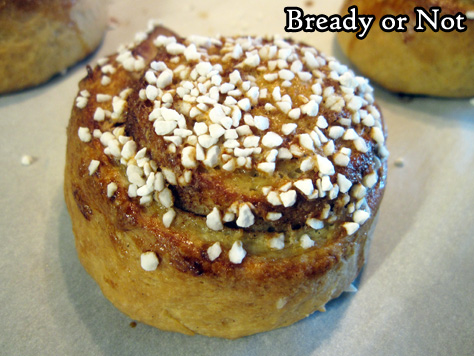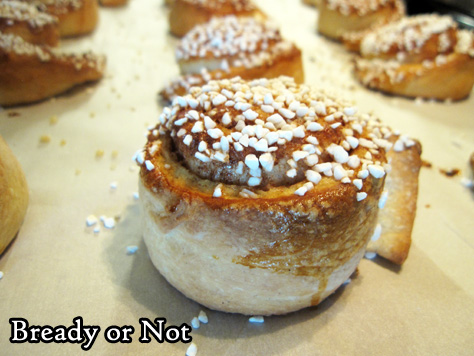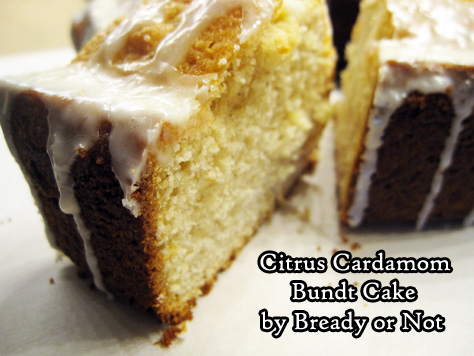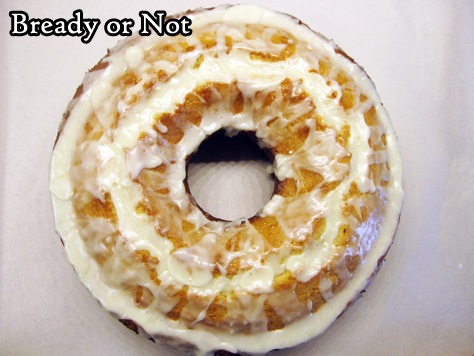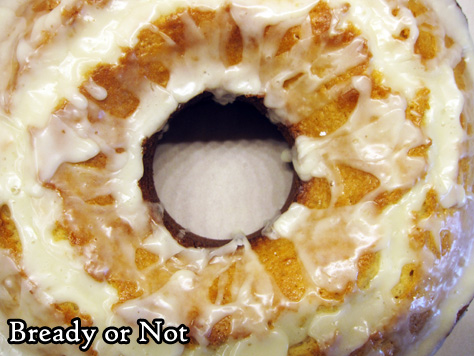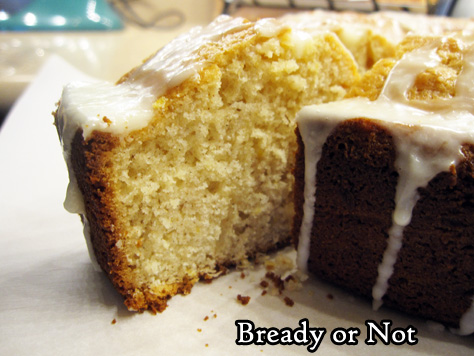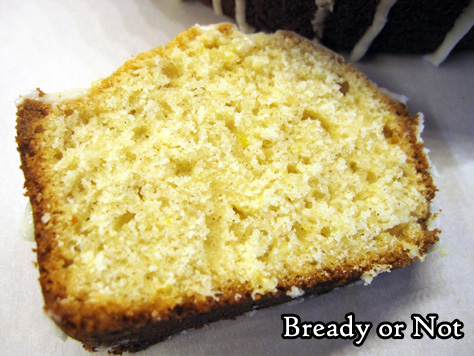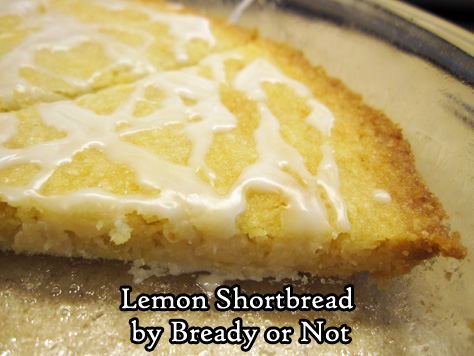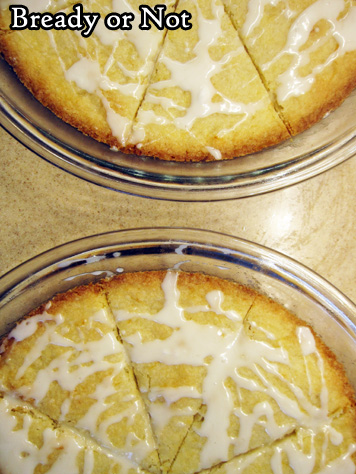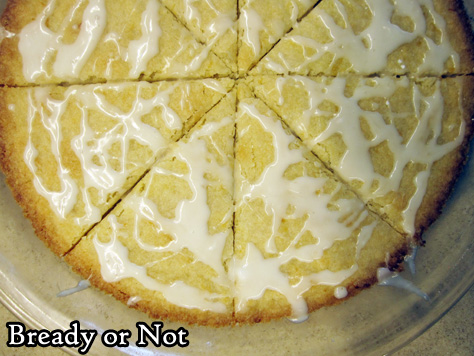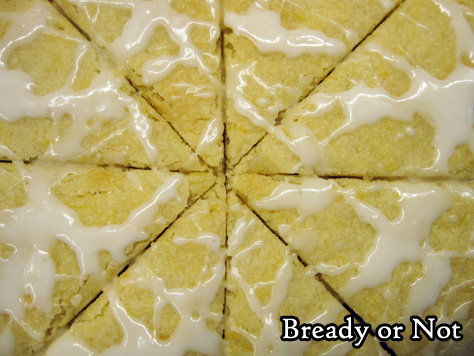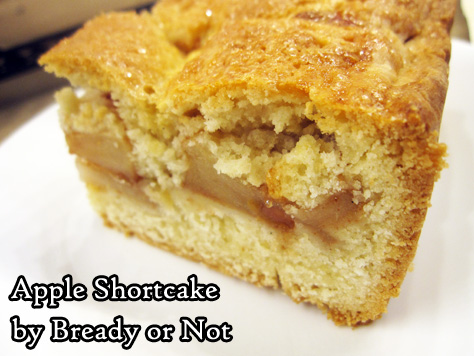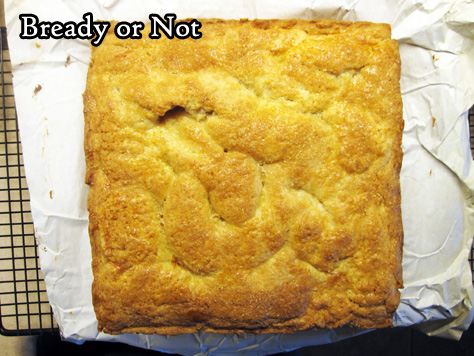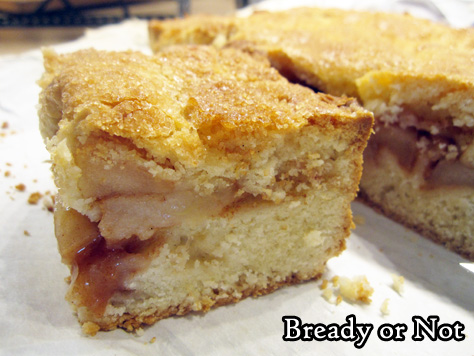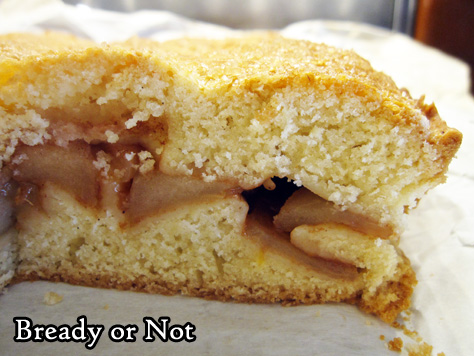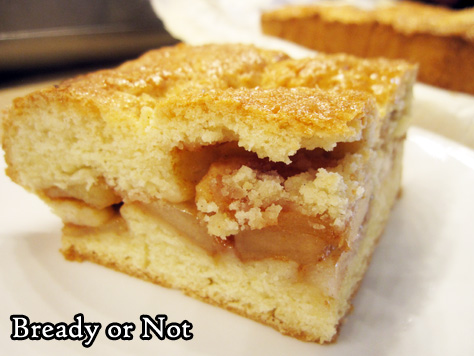Bready or Not: Dutch Butter Cake (Boterkoek)
If you want a cake that is simple yet indulgent, this Dutch Butter Cake is for you. It’s a single-layer cake that is straightforward to make.
Really, the fussiest thing about this recipe is doing the crosshatch pattern on the top, and it’s not that bad. Look at my pictures–or others online–for examples of what to do.
The prettiness of the cake is what initially drew me in, and then when I saw it was called a Butter Cake, I knew I had to make it. I mean, butter. I’m of Southeastern American stock on both sides. I was raised with the philosophy that butter makes everything better except for things like sucking chest wounds.
This cake bakes up with a light, tender crumb. The fresh orange zest shines through along with the butter and vanilla. It’s rich even as it’s not heavily sweet.
Modified from Bake from Scratch March/April 2020.
Bready or Not: Dutch Butter Cake (Boterkoek)
Equipment
- 9-inch springform pan
- parchment paper
- plastic wrap
- pastry brush
Ingredients
- 1 1/2 cups unsalted butter 3 sticks, softened
- 1 1/4 cups white sugar
- 1/2 cup brown sugar packed
- 1 orange zested
- 2 large eggs divided
- 1 1/2 teaspoon vanilla bean paste
- 2 1/2 cups all-purpose flour
- 1/2 cup unbleached cake flour
- 1 teaspoon kosher salt
- 1/4 teaspoon ground nutmeg
Instructions
- Preheat oven 350-degrees.
- Cut a piece of parchment to fit in the bottom of a 9-inch springform pan. Apply nonstick spray or butter over the inside of the pan, place the parchment inside, then grease it as well. Set aside.
- In a stand mixer, beat the butter, sugars, and orange zest together. Scrape the bottom of the bowl, then beat on medium until fluffy, about 2 to 3 minutes. Add 1 egg. Crack the 2nd egg, placing the yolk with the other ingredients and setting aside the white for later use. Add vanilla bean paste to other ingredients and combine.
- In a separate bowl, stir together flours, salt, and nutmeg. Gradually add dry ingredients into the butter batter to create a thick dough. Scoop it into the prepared pan.
- Use a piece of plastic wrap to press the dough into an even layer. Discard plastic wrap. Lightly beat the reserved egg white. Use a pastry brush to gently apply the egg white across the top of the cake. Use the tines of a fork to make a crosshatch pattern across the top.
- Bake for 25 minutes. Rotate the pan. Continue baking until the surface is golden brown and the middle passes the toothpick test, which should be after an additional 5 to 10 minutes. Let cake cool in pan for 10 minutes, then release the side latch to remove the ring.
- Let cake cool completely on a wire rack. Slice and enjoy. Cake keeps well covered at room temperature for at least 3 days. It can also be cut into slices and frozen for later enjoyment.
OM NOM NOM!
Bready or Not: Sharlotka (Apple Cake)
As you might have noticed, I’ve been experimenting with many different kinds of apple cakes over the past while. This Sharlotka has a Russian name but British origins, because that’s the way of the world.
I modified this from a recipe in Bake from Scratch’s October 2020 issue. There, they say the first Sharlotka was a very different kind of cake that was served for Czar Alexander during a London visit–and made by a French chef. Because of course.
The cake that evolved after that became more of a basic apple cake. The batter is minimal, and beaten for a prolonged time to increase volume. It’s pretty much there to act like adhesive for the mélange of apples.
The resulting cake is light and airy. The flavor of the apples really shines through.
This cake is great for a breakfast, snack, or dessert. Eat it on its own, or with some ice cream.
Bready or Not: Sharlotka (Apple Cake)
Equipment
- 9-inch springform pan
- parchment paper
- fine mesh sieve
- offset spatula
Ingredients
- 4 medium apples such as Granny Smith, Ambrosia, Fuji, or Golden Delicious; go for a mix!
- 1 cup plus 1 Tablespoon white sugar divided
- 1 large orange or 1 large lemon zested and juiced
- 4 large eggs room temperature
- 1 1/2 teaspoons vanilla extract or vanilla bean paste
- 3/4 teaspoon kosher salt
- 1 1/4 cups all-purpose flour
- 1 1/2 teaspoons baking powder
- 1/2 teaspoon ground cinnamon
- 1/4 teaspoon ground cardamom
- confectioners’ sugar for dusting
Instructions
- Preheat oven at 350-degrees. Cut parchment to fit the bottom of the springform pan. Grease the pan, then place in parchment round, then spray that as well.
- Peel and thinly slice the apples. In a big bowl, coat the apples with 1 Tablespoon white sugar, the citrus zest, and 2 teaspoons of fresh juice. Set aside.
- In the bowl of a stand mixer with a whisk attachment, beat eggs, vanilla, salt, and remaining 1 cup of sugar at medium high speed for about 7 minutes. It should turn thick and pale, the batter forming ribbons when the whisk is lifted up. Remove bowl from mixer.
- In a medium bowl, combine flour, baking powder, cinnamon, and cardamom. Use a fine-mesh sieve to sift the dry ingredients into the egg mix. Gently fold the flour in until it’s just combined and there are no white streaks.
- Place half the apples in the prepared pan. Pour half the batter over them. Use an offset spatula to work the batter into nooks and crannies. Scatter the rest of the apples on top, followed by the rest of the batter. Again, use the spatula to spread the small amount of batter. For a couple minutes, thump the pan on the counter and tap the sides every now and then to cause bubbles to rise, smoothing batter again after.
- Bake cake. Check it at 30 minutes to see if it is getting too brown; if so, cover it with foil. Continue baking 10 more minutes (40 total) then test the middle with a toothpick. If it comes out clean, the cake is done. Let it cool on a rack for 15 minutes before carefully releasing the sides of the pan.
- Serve the cake warm, at room temperature, or cold from the fridge. Add a dusting of confectioners’ sugar on top for serving; if keeping cake for later, add fresh sugar each time, as it will gradually be absorbed. Store covered in the fridge or at room temperature.
OM NOM NOM!
Bready or Not: Swedish Cinnamon Rolls in the Bread Machine
Cinnamon Rolls in most any form are awesome. This version, with a top of crusted Swedish Pearl Sugar, is wonderfully crunchy and not as hardcore-sweet as frosting variations.
First of all, I know people are already asking: what is Swedish Pearl Sugar? It’s sugar that consists of large granules that hold their shape while baking at moderate temperatures. No, you cannot substitute with regular sugar or even turbinado sugar. Pearl Sugar is unique.
I like Lars’ Own brand. I get it off of Amazon, and you can, too. [affiliate link] I have a number of other recipes on Bready or Not that utilize Pearl Sugar as well. I can help you use up that bag!
So, enough about the sugar. The recipe here is written for the bread machine, but of course, modify to make it in a stand mixer or by hand. This is an enriched dough, meaning it has eggs and butter, so expect it to have a yellow tint.
The baked-up rolls are divine little swirls that are incredibly fun to unspool. The Pearl Sugar adds a satisfying crunch in contrast to the soft, buttery bread.
This is a great recipe for a special breakfast or dessert–but do keep in mind that they are best eaten within a day. After that, they get stodgy, but they are still edible. I highly recommend freezing some rolls very soon after baking, as they will thaw later as if they were just made!
Bready or Not: Swedish Cinnamon Rolls in the Bread Machine
Equipment
- bread machine
- large baking sheet
- parchment paper
Ingredients
Dough
- 1 1/2 sticks unsalted butter 3/4 cup
- 1 cup milk
- 1/4 teaspoon sea salt
- 1/4 cup white sugar
- 3 cups all-purpose flour
- 1 teaspoon cardamom
- 2 1/4 teaspoons dry yeast one packet
Filling
- 2 Tablespoons unsalted butter softened
- 3 Tablespoons white sugar
- 1/2 Tablespoon ground cinnamon
Glaze
- 1 egg room temperature, lightly beaten
- 1/4 cup Swedish pearl sugar
Instructions
- Melt butter on the stove top or in the microwave. Add milk and heat until they are lukewarm. Place in bread machine. Add sugar, salt, flour, cardamom, and yeast. Begin dough cycle on machine. Check on dough as it mixes, adding more flour or milk, if needed. Let it complete its first rise.
- Line a large baking sheet with parchment paper.
- Lightly flour a surface. Dump out dough and roll it out into a rectangle about 1/3″ thick. Spread softened butter all over the surface. Stir together the sugar and cinnamon, then sprinkle it over the butter. Roll the dough up to form a long log.
- Use a sharp knife or a piece of unwaxed dental floss to slice up 12 individual rolls. Set spaced out on prepared pan. Cover with plastic wrap or a towel to rise for 30 minutes. In the meantime, preheat oven at 425-degrees.
- Brush beaten egg atop rolls. Sprinkle them with pearl sugar. Bake for 12-15 minutes, until golden brown. A digital thermometer in the middle of a center roll should read over 190-degrees. Cool for at least 15 minutes before eating.
- Swedish Cinnamon Rolls are best eaten within a day. If promptly frozen, they will keep for a prolonged period–just eat them soon after thawing.
OM NOM NOM!
Bready or Not Original: Citrus Cardamom Bundt Cake
This Citrus Cardamom Bundt Cake beautifully combines orange and lemon with classic spices, creating a cake that tastes and smells divine.
Above all, this cake is imbued with wonderful freshness. Citrus does that, and this cake has a heady dose in the batter as well as the glaze.
Cardamom is one of my favorite spices, one that I crave to use more often. A teaspoon and a half is in this recipe, and as strong as cardamom is, it comes through in a potent, refreshing way.
I made it in a tube pan, because I had a brand new one I needed to try out, but this would also be great in a large bundt pan.
Make this to feed a crowd for breakfast, brunch, or dessert. It would be delicious at any time of day or during any season of the year!
Bready or Not Original: Citrus Cardamom Bundt Cake
Equipment
- tube or bundt pan
- baking spray with flour
Ingredients
cake:
- 3 cups all-purpose flour
- 1 1/2 cups white sugar
- 2 teaspoons baking powder
- 1 1/2 teaspoons ground cardamom
- 1/2 teaspoon ground cinnamon
- 1/2 teaspoon salt
- 1/2 cup orange juice
- 2 large lemons zested and juiced
- 2/3 cup canola oil
- 1 teaspoon vanilla extract
- 3 large eggs room temperature
glaze:
- 1 cup confectioners’ sugar
- 3 teaspoons orange juice
- 1 teaspoon lemon juice from reserved juice
Instructions
- Preheat oven at 350-degrees. Use a floured baking spray on the entire interior of a bundt or tube pan.
- Combine the flour, sugar, baking powder, cardamom, cinnamon, and salt. Pour in the 1/2 cup orange juice, 1/4 cup of the fresh lemon juice, canola oil, all of the lemon zest, vanilla, and eggs. Beat until combined, scraping the bottom of the bowl occasionally.
- Pour the batter into the pan and level it. Bake for 45 to 55 minutes, until a toothpick comes out clean. Let cool in pan for about 15 minutes before inverting onto a wire rack.
- After another 10 minutes, assemble glaze to create a thick, slow-dribbling consistency. Drip it over the warm cake to coat the top and ooze along the sides. Cool cake completely.
- Store cake covered at room temperature. Pieces can be individually sliced to take on the go or to freeze for later.
OM NOM NOM!
Bready or Not Original: Lemon Shortbread
My Shortbread recipe was the first I really mastered as a teenager beginning to bake. This new version uses that as a base, but modifies it into a delicious Lemon Shortbread.
I love a good Scottish Shortbread. It’s so buttery and scrumptious. The fresh zing of lemon plays very well with that inherent butter flavor and texture.
This is not a crisp shortbread like the traditional Walker’s brand (which is delicious in its own right). No, this shortbread is cakey and soft, only crisp at the very edge.
Sometimes the first piece out of the pan can even be fussy and break in half; a metal pie spatula helps, but sometimes it can still happen. That’s no major problem, though, because of every bite of Shortbread is good, even if it’s not perfectly photogenic.
This new version does have a photogenic advantage, though, because the glaze is so very pretty. It should be just thick enough to drizzle, though if it’s a touch watery, that’s not the end of the world.
Enjoy this Lemon Shortbread for breakfast or snacks, or in proper fashion at tea time.
Bready or Not Original: Lemon Shortbread
Equipment
- 2 pie plates
Ingredients
Shortbread
- 1 lemon zested and juiced
- 2 cups all-purpose flour
- 3/4 cup white sugar
- 1/4 teaspoon salt
- 1 cup unsalted butter (2 sticks) softened
- 1 egg yolk
- 1 teaspoon lemon flavor
- 1/2 teaspoon vanilla extract
Lemon Glaze
- 3/4 cup confectioners’ sugar
- 1 Tablespoon lemon juice
Instructions
- Preheat oven at 375-degrees. Apply nonstick spray to both pie plates.
- Stir together the lemon zest, flour, sugar, and salt. Add butter, egg yolk, lemon flavor, and vanilla extract. Use hands to compress dough together to make a ball. Divide in half, placing one in each pie plate. Flatten dough with palms to create an even surface. Prick surface all over with a fork then use a knife to slash dough into triangular wedges.
- Bake for 18 to 22 minutes, until edges are golden brown and middle is set. Remove from oven and cut again along slash marks. Let shortbread cool completely.
- In a medium bowl, stir together confectioners’ sugar and lemon juice to create a glaze with a consistency to drip and keep shape. Drizzle all over shortbread. Let set, then cut again along existing marks.
- Shortbread keeps for several days at room temperature. It can be stored covered in pie plates, or stacked in a sealed container with wax paper between the layers.
OM NOM NOM!
Bready or Not: Apple Shortcake
This Apple Shortcake is fussy to make, but the results are absolutely delicious!
I modified this from a recipe in Bake from Scratch, the September/October 2020 issue. There, they describe this style of shortcake as a New Zealand favorite.
Here in American, I grew up with strawberry shortcake (and loved the cartoon and toys for Strawberry Shortcake in my earliest years), and thought of fruit shortcakes as being simply made in individual portions. I was intrigued by this idea of it being like a cake and pie hybrid.
The most annoying thing about the recipe is that I found the dough to be quite sensitive–but this also might be an Arizona problem, as my kitchen year-round is hotter than many get. The good thing is that the recipe makes a lot of dough, so it’s easy to patch any tears or holes with a bit of the leftovers.
The baked shortcake is dense and delicious, with perfectly-spiced apples in a kind of shortbread sandwich.
The shortbread keeps okay at room temperature up to 2 days. If you’re feeding a small crowd, no prob–cut it into individual pieces, encase in plastic wrap, and freeze. It keeps fantastically that way.
Modified a lot from Bake from Scratch, September/October 2020 issue.
Bready or Not: Apple Shortcake
Equipment
- food processor
- food scale
- 9×9 pan
- Rolling Pin
- pastry brush
Ingredients
- 4 cups all-purpose flour plus more for rolling
- 1 cup plus 3 Tablespoons white sugar divided
- 1 3/4 teaspoons baking powder
- 1 1/4 teaspoons plus 1/8 teaspoons kosher salt divided
- 1 cup cold unsalted butter
- 3 large eggs divided
- 3/4 teaspoons almond extract
- 1/2 teaspoon vanilla extract
- 3 large apples such as Granny Smith and Pink Lady
- 1 lemon zested and juiced
- 2 teaspoons corn starch
- 1 teaspoon ground cinnamon
- turbinado sugar optional to sprinkle on top
Instructions
Make the crust
- In the bowl of a food processor, pour in the flour, 1 cup sugar, baking powder, and 1 1/4 teaspoons salt, then pulse until combined. Cut the butter into cubes and add to the bowl, pulsing until the mixture resembles coarse crumbs. Add 2 eggs and the extracts. Pulse to bring the dough together so that it's moist but not sticky; if it doesn't come together, add a small amount of water and pulse more.
- Turn out the dough to press it together. Use a food scale to weigh the dough and divide it in two. Wrap each piece with plastic wrap. Chill in fridge for at least 30 minutes, or up to a few days.
Assemble the shortcake
- Preheat oven at 350-degrees. Let the dough stand at room temperature for about 10 minutes. Sprinkle flour on a flat surface and roll out one portion of dough to make a 13-inch square. Set the pan on top as a guide to cut an even 9×9 square.
- Line pan with foil and apply nonstick spray. Place cut square inside. It’s okay if it tears as its being moved–patch it with fingertips. Pat the leftover dough up the sides of the pan to completely cover, sealing the edges together along the bottom and at the corners. Chill pan during the next step.
- Peel the apples and cut into quarter-inch slices, placing them in a large bowl. Add the lemon zest and 2 teaspoons of juice. Stir to coat apples. Add the cornstarch, cinnamon, remaining 3 Tablespoons sugar, and last bit of salt. Toss everything together, coating the apples. Spread the apples evenly across the bottom of the pan.
- Roll out remaining dough to make a 10-inch square to completely cover the top of the apples. Press overlapping edges to seal together, trimming dough if needed. Lightly beat the remaining egg then brush it over the top crust. Use a fork to poke the crust all over to create vents. If desired, sprinkle turbinado sugar across the crust.
- Bake until crust is golden brown, about 50 minutes to 1 hour. The apples should be tender if poked with a toothpick. Let cool in pan for at least an hour. Use foil to lift shortcake onto a cutting board for easy slicing.
- Store cake in sealed container at room temperature for up to 2 days. It can also be cut into individual slices and frozen for later enjoyment.




